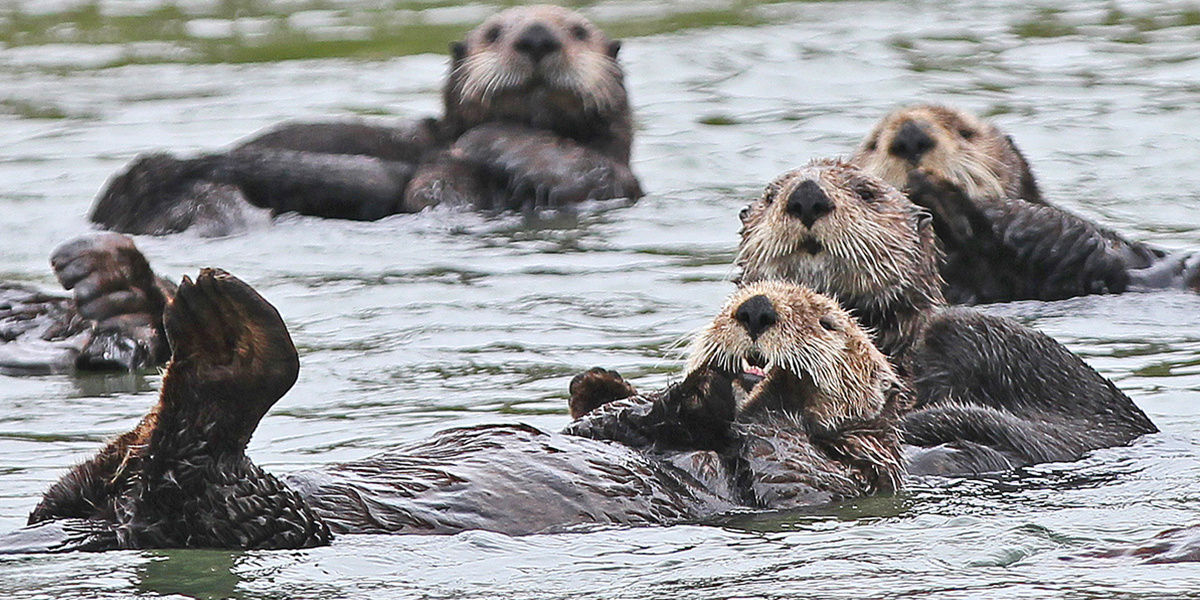
Sea Otters, Alligators and Other Major Predators Are Reclaiming Historic Niches, Study Finds

Sea otters in Elkhorn Slough, CA, an area of salt marshes and seagrass beds not usually considered their habitat. Judy Gallagher / Flickr / CC BY 2.0
Increasingly, large predators like mountain lions, alligators and killer whales are moving into ecosystems not traditionally associated with them. Mountain lions have been spotted prowling grasslands, alligators have been seen lounging on Florida beaches and killer whales have been spied swimming in freshwater rivers.
Many hypothesized that the animals were taking over new territories as their populations rebounded due to conservation efforts. But research published in Current Biology Monday suggests that they are actually taking back what was rightfully theirs.
The researchers looked specifically at sea otters on the Pacific coast of the U.S., who have expanded from kelp forests to estuaries, salt marshes and seagrass beds, and alligators in the Southeastern U.S., who have expanded from freshwater swamps into marine habitats like mangroves and seagrasses. The researchers argued, based on both the species’ success in these “new” habitats when protected from human interference, as well as historical and archaeological evidence placing both sea otters and alligators in coastal marshes, that the predators were reconquering ground they had occupied before human activity drove them out.
“We can no longer chock up a large alligator on a beach or coral reef as an aberrant sighting,” study co-author and Rachel Carson associate professor of Marine Conservation Biology at Duke’s Nicholas School of the Environment Brian Silliman said in a Duke University press release. “It’s not an outlier or short-term blip. It’s the old norm, the way it used to be before we pushed these species onto their last legs in hard-to-reach refuges. Now, they are returning,” he said.
The study’s authors, who, in addition to Duke, came from the University of California Santa Cruz, the U.S. Geological Survey, the University of Florida and Kansas State University, suggested that the same might be true of other large predators moving into new niches, though more research needs to be conducted to confirm this hypothesis.
Examples of other potential reconquests include the movement of orangutans into disturbed forests, river otters into marine wetlands, canines like wolves and coyotes onto beaches and rocky shores and grey, harbor and harp seals from Arctic into subtropical waters.
Taken together, these movements also indicate that large predators are more adaptive than ecologists thought.
“The assumption, widely reinforced in both the scientific and popular media, is that these animals live where they live because they are habitat specialists. Alligators love swamps; sea otters do best in saltwater kelp forests; orangutans need undisturbed forests; marine mammals prefer polar waters. But this is based on studies and observations made while these populations were in sharp decline. Now that they are rebounding, they’re surprising us by demonstrating how adaptable and cosmopolitan they really are,” Silliman said in the press release.
This is good news for both predators and the ecosystems they are calling home again.
In the press release, Stillman used the example of sea otters’ movement into estuaries. This habitat flexibility will help sea otters survive as kelp forests are threatened due to climate change. But it also helps estuaries, because the sea otters eat Dungeness crabs who otherwise eat too many of the sea slugs that prevent the estuaries from being overrun by epiphytic algae fertilized by urban and agricultural runoff.
The study’s conclusion argued that its findings should be taken into consideration when determining conservation policy.
“As many of these consumers (and their habitats) are protected and managed by legislation, the habitats they are now re-colonizing (e.g., salt marshes) will also need to be considered as critical habitat in recovery plans. Indeed, as is the case with sea otters and alligators, these ‘novel’ ecosystems can potentially support much higher populations than current habitats listed as critical,” the study’s authors wrote.
New Study Is First to Demonstrate That Biodiversity Inoculates Against Extinction https://t.co/GsoGXgDP2b @World_Wildlife @foeeurope @globalactplan
— EcoWatch (@EcoWatch) March 12, 2018
- It's Time for a More Realistic Approach to Conservation
- Restoring Seagrasses Can Bring Coastal Bays Back to Life
- Otters Can Learn From Each Other and This Might Help Them Survive, Study Finds - EcoWatch
- Shining a Species Spotlight on the Asian Small-Clawed Otter
- Giant Otter Believed to Be Extinct Resurfaces (Literally) in Argentina

 233k
233k  41k
41k  Subscribe
Subscribe 